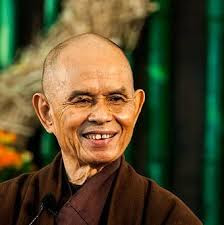Buddhist meditation is a practice of looking deeply into the nature of reality. Because we don't have enough concentration, mindfulness, we cannot look deeply. We can be deceived by what we see and by what we hear. It's like a science. Science is also an attempt to look more deeply. You look at a sky and you see a star. You strongly believe that the star is there. But it may be that the star had already disappeared one thousand-year of light ago. And that is why you can be deceived by what you see and by what you hear. And science helps us to be more careful. And Buddhism does the same. If you look deeply, and then you can be free from wrong perceptions, from illusions. Like the illusion that life is permanent, there is a permanent soul inhabiting in each living being. These kind of things.
The Buddha did have a teacher. He followed a number of teachers. And he practiced with a community. And he had made some progress in his path of looking deeply. But he realized finally that these kinds of realization was not enough for his liberation. And that is why he had to continue by himself. And sitting at the foot of a Bodhi tree, he was able to make a breakthrough. He discovered the nature of interdependence, the nature of interbeing. He discovered a way of looking deeply and he could transcend the idea of birth and death, coming and going, being and non-being. And he was completely liberated from suffering. The happiness, the salvation of the Buddha was possible thanks to Maha Prajna (great understanding). And when you get the great understanding, you are no longer afraid of being born, of dying. And that is why you want to share your insight and your practice with other people.
:Unquote
(My commentary)
A way of looking deeply Buddha discovered is to attain insight through mindfulness and concentration. First of all, we need to revive awareness, or transform ourselves from ego (separate self) to true self (non-separate self = awareness) through mindfulness. Secondly, we need to concentrate our mind to understand the true nature of reality or the root cause. This great understanding is attained as insight, not as knowledge through thinking. So, the key for insight is to stop thinking through mindful breathing. Non-thinking sounds easy but may not be so easy for ego, especially for intelligent ego.
(Cf.) http://www.amazon.com/dp/B014NYEP04
Thích Nhất Hạnh

















